Telstra's Financial Performance: Business Report Analysis
VerifiedAdded on 2022/08/21
|11
|1881
|15
Report
AI Summary
This business report provides a detailed analysis of Telstra's financial performance over a 15-year period. It examines key financial ratios such as the current ratio, debt-to-equity ratio, times interest earned, and return on assets to evaluate the company's liquidity, capital structure, and profitability. The report also includes statistical analysis, including beta analysis, to assess the risk associated with investing in Telstra. The findings indicate that Telstra has generally maintained a balanced debt-to-equity ratio and a good reputation for debt repayment, though its return on assets has not been as strong as industry standards. The report concludes with recommendations for improving liquidity and asset utilization, alongside investment advice. This report is a valuable resource for understanding Telstra's financial health and making informed investment decisions.
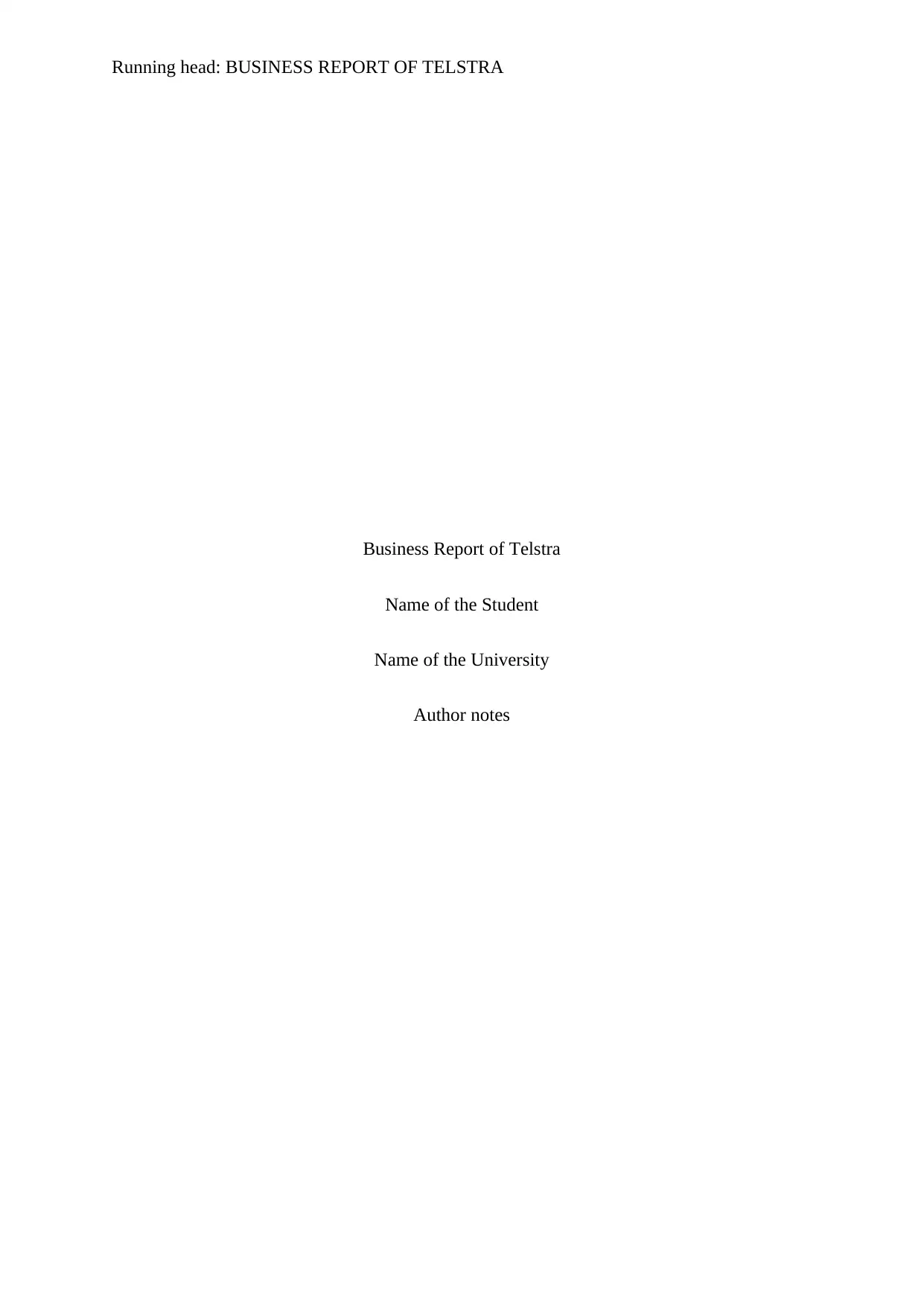
Running head: BUSINESS REPORT OF TELSTRA
Business Report of Telstra
Name of the Student
Name of the University
Author notes
Business Report of Telstra
Name of the Student
Name of the University
Author notes
Paraphrase This Document
Need a fresh take? Get an instant paraphrase of this document with our AI Paraphraser
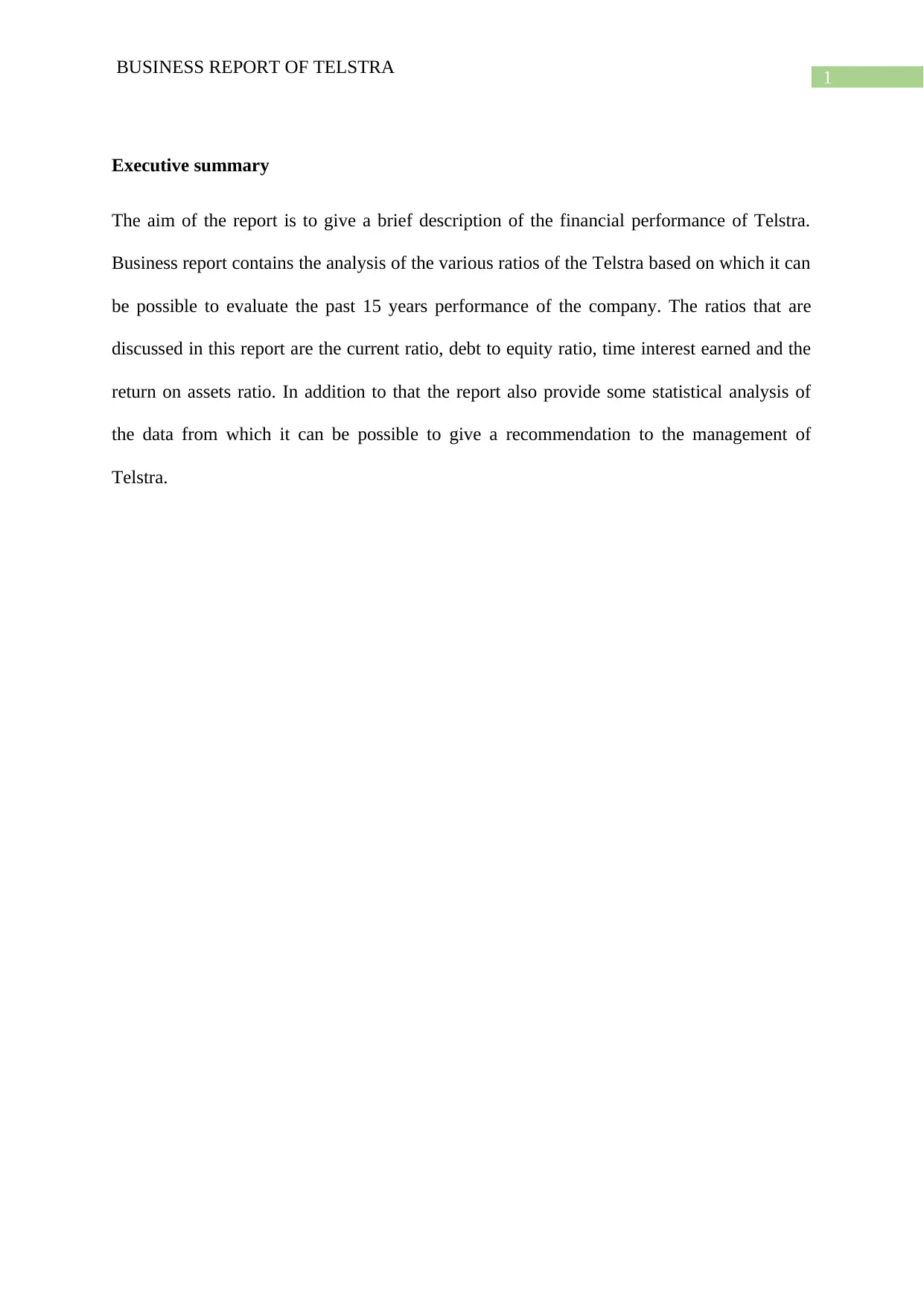
1
BUSINESS REPORT OF TELSTRA
Executive summary
The aim of the report is to give a brief description of the financial performance of Telstra.
Business report contains the analysis of the various ratios of the Telstra based on which it can
be possible to evaluate the past 15 years performance of the company. The ratios that are
discussed in this report are the current ratio, debt to equity ratio, time interest earned and the
return on assets ratio. In addition to that the report also provide some statistical analysis of
the data from which it can be possible to give a recommendation to the management of
Telstra.
BUSINESS REPORT OF TELSTRA
Executive summary
The aim of the report is to give a brief description of the financial performance of Telstra.
Business report contains the analysis of the various ratios of the Telstra based on which it can
be possible to evaluate the past 15 years performance of the company. The ratios that are
discussed in this report are the current ratio, debt to equity ratio, time interest earned and the
return on assets ratio. In addition to that the report also provide some statistical analysis of
the data from which it can be possible to give a recommendation to the management of
Telstra.
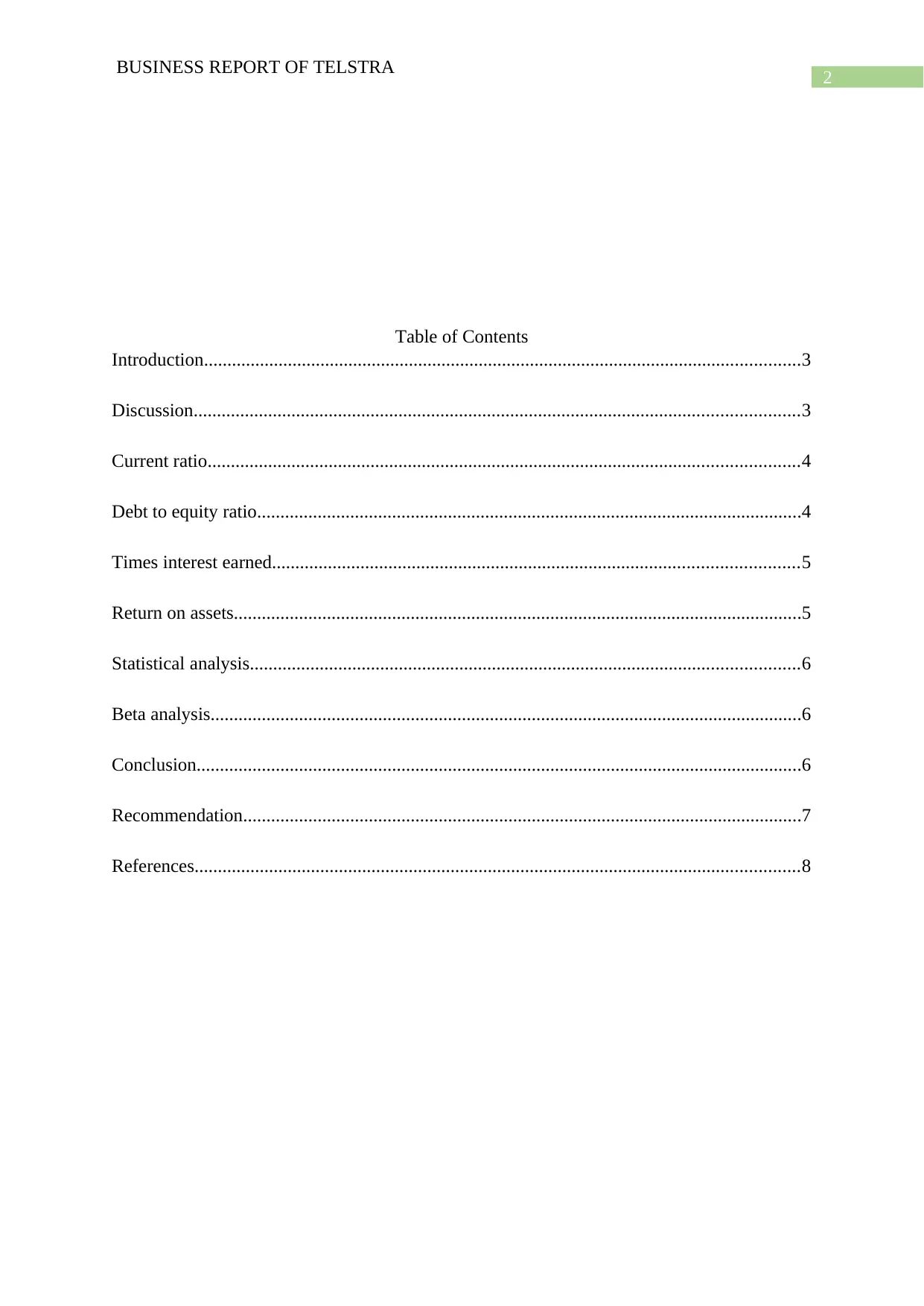
2
BUSINESS REPORT OF TELSTRA
Table of Contents
Introduction................................................................................................................................3
Discussion..................................................................................................................................3
Current ratio...............................................................................................................................4
Debt to equity ratio.....................................................................................................................4
Times interest earned.................................................................................................................5
Return on assets..........................................................................................................................5
Statistical analysis......................................................................................................................6
Beta analysis...............................................................................................................................6
Conclusion..................................................................................................................................6
Recommendation........................................................................................................................7
References..................................................................................................................................8
BUSINESS REPORT OF TELSTRA
Table of Contents
Introduction................................................................................................................................3
Discussion..................................................................................................................................3
Current ratio...............................................................................................................................4
Debt to equity ratio.....................................................................................................................4
Times interest earned.................................................................................................................5
Return on assets..........................................................................................................................5
Statistical analysis......................................................................................................................6
Beta analysis...............................................................................................................................6
Conclusion..................................................................................................................................6
Recommendation........................................................................................................................7
References..................................................................................................................................8
⊘ This is a preview!⊘
Do you want full access?
Subscribe today to unlock all pages.

Trusted by 1+ million students worldwide
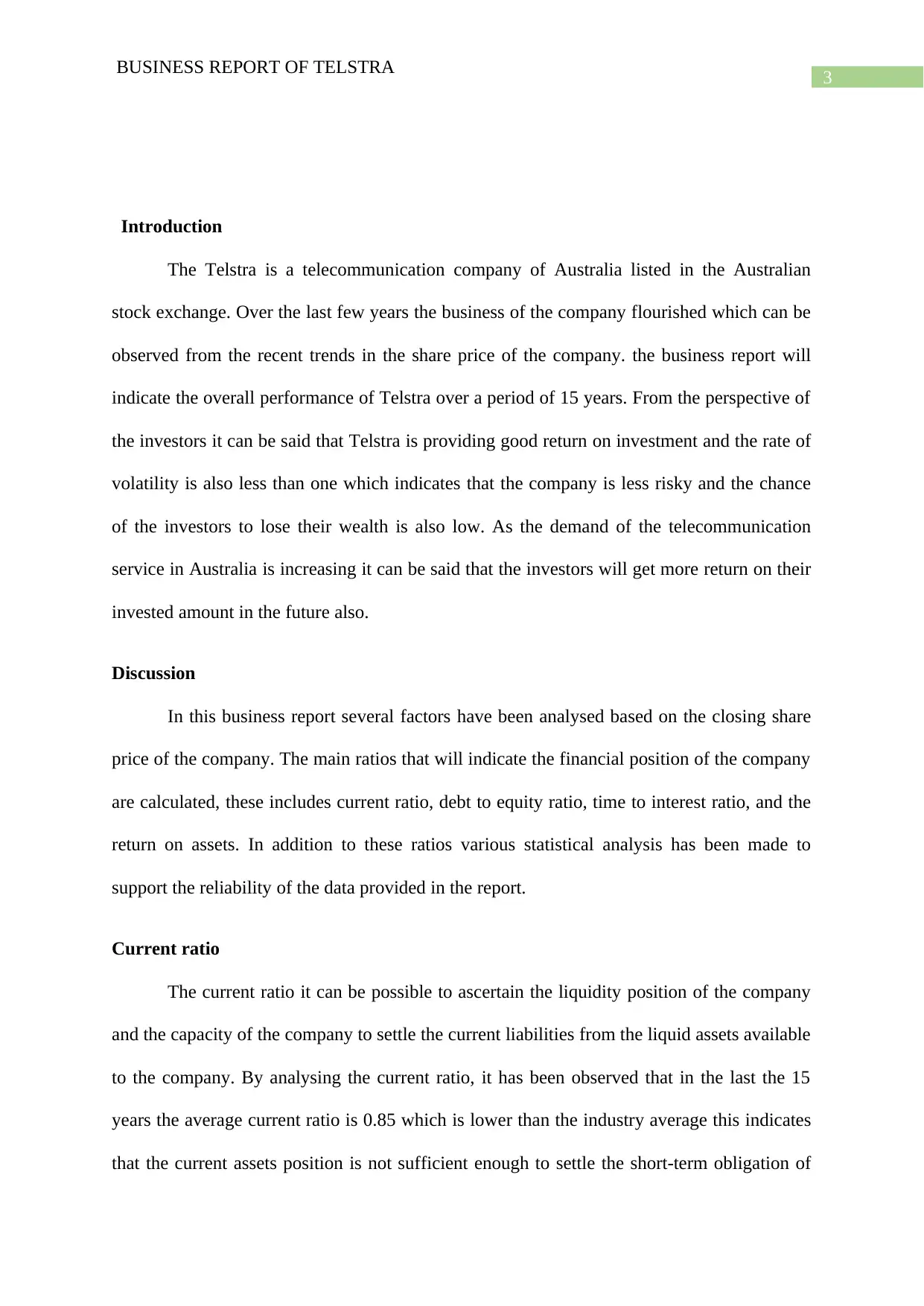
3
BUSINESS REPORT OF TELSTRA
Introduction
The Telstra is a telecommunication company of Australia listed in the Australian
stock exchange. Over the last few years the business of the company flourished which can be
observed from the recent trends in the share price of the company. the business report will
indicate the overall performance of Telstra over a period of 15 years. From the perspective of
the investors it can be said that Telstra is providing good return on investment and the rate of
volatility is also less than one which indicates that the company is less risky and the chance
of the investors to lose their wealth is also low. As the demand of the telecommunication
service in Australia is increasing it can be said that the investors will get more return on their
invested amount in the future also.
Discussion
In this business report several factors have been analysed based on the closing share
price of the company. The main ratios that will indicate the financial position of the company
are calculated, these includes current ratio, debt to equity ratio, time to interest ratio, and the
return on assets. In addition to these ratios various statistical analysis has been made to
support the reliability of the data provided in the report.
Current ratio
The current ratio it can be possible to ascertain the liquidity position of the company
and the capacity of the company to settle the current liabilities from the liquid assets available
to the company. By analysing the current ratio, it has been observed that in the last the 15
years the average current ratio is 0.85 which is lower than the industry average this indicates
that the current assets position is not sufficient enough to settle the short-term obligation of
BUSINESS REPORT OF TELSTRA
Introduction
The Telstra is a telecommunication company of Australia listed in the Australian
stock exchange. Over the last few years the business of the company flourished which can be
observed from the recent trends in the share price of the company. the business report will
indicate the overall performance of Telstra over a period of 15 years. From the perspective of
the investors it can be said that Telstra is providing good return on investment and the rate of
volatility is also less than one which indicates that the company is less risky and the chance
of the investors to lose their wealth is also low. As the demand of the telecommunication
service in Australia is increasing it can be said that the investors will get more return on their
invested amount in the future also.
Discussion
In this business report several factors have been analysed based on the closing share
price of the company. The main ratios that will indicate the financial position of the company
are calculated, these includes current ratio, debt to equity ratio, time to interest ratio, and the
return on assets. In addition to these ratios various statistical analysis has been made to
support the reliability of the data provided in the report.
Current ratio
The current ratio it can be possible to ascertain the liquidity position of the company
and the capacity of the company to settle the current liabilities from the liquid assets available
to the company. By analysing the current ratio, it has been observed that in the last the 15
years the average current ratio is 0.85 which is lower than the industry average this indicates
that the current assets position is not sufficient enough to settle the short-term obligation of
Paraphrase This Document
Need a fresh take? Get an instant paraphrase of this document with our AI Paraphraser
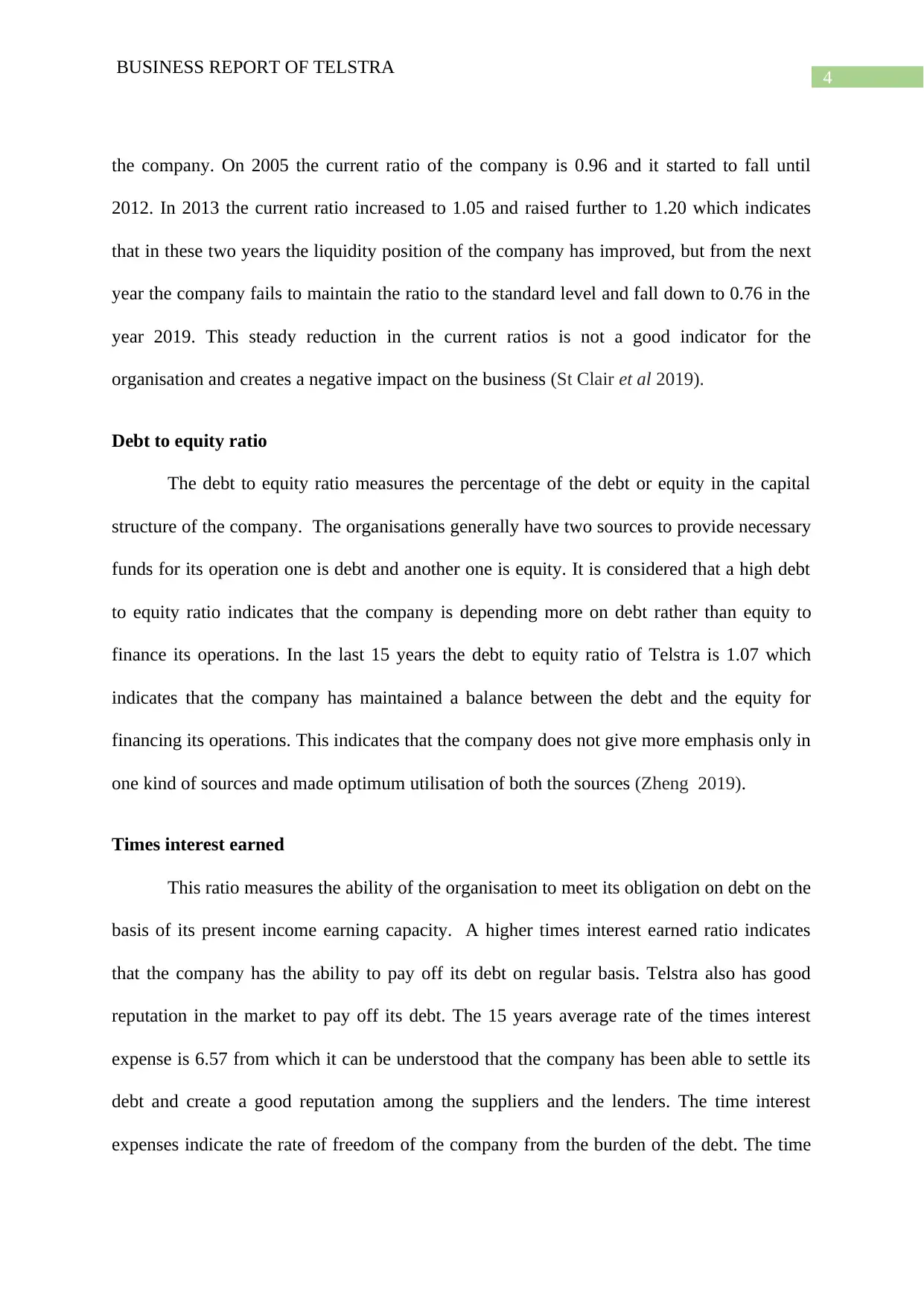
4
BUSINESS REPORT OF TELSTRA
the company. On 2005 the current ratio of the company is 0.96 and it started to fall until
2012. In 2013 the current ratio increased to 1.05 and raised further to 1.20 which indicates
that in these two years the liquidity position of the company has improved, but from the next
year the company fails to maintain the ratio to the standard level and fall down to 0.76 in the
year 2019. This steady reduction in the current ratios is not a good indicator for the
organisation and creates a negative impact on the business (St Clair et al 2019).
Debt to equity ratio
The debt to equity ratio measures the percentage of the debt or equity in the capital
structure of the company. The organisations generally have two sources to provide necessary
funds for its operation one is debt and another one is equity. It is considered that a high debt
to equity ratio indicates that the company is depending more on debt rather than equity to
finance its operations. In the last 15 years the debt to equity ratio of Telstra is 1.07 which
indicates that the company has maintained a balance between the debt and the equity for
financing its operations. This indicates that the company does not give more emphasis only in
one kind of sources and made optimum utilisation of both the sources (Zheng 2019).
Times interest earned
This ratio measures the ability of the organisation to meet its obligation on debt on the
basis of its present income earning capacity. A higher times interest earned ratio indicates
that the company has the ability to pay off its debt on regular basis. Telstra also has good
reputation in the market to pay off its debt. The 15 years average rate of the times interest
expense is 6.57 from which it can be understood that the company has been able to settle its
debt and create a good reputation among the suppliers and the lenders. The time interest
expenses indicate the rate of freedom of the company from the burden of the debt. The time
BUSINESS REPORT OF TELSTRA
the company. On 2005 the current ratio of the company is 0.96 and it started to fall until
2012. In 2013 the current ratio increased to 1.05 and raised further to 1.20 which indicates
that in these two years the liquidity position of the company has improved, but from the next
year the company fails to maintain the ratio to the standard level and fall down to 0.76 in the
year 2019. This steady reduction in the current ratios is not a good indicator for the
organisation and creates a negative impact on the business (St Clair et al 2019).
Debt to equity ratio
The debt to equity ratio measures the percentage of the debt or equity in the capital
structure of the company. The organisations generally have two sources to provide necessary
funds for its operation one is debt and another one is equity. It is considered that a high debt
to equity ratio indicates that the company is depending more on debt rather than equity to
finance its operations. In the last 15 years the debt to equity ratio of Telstra is 1.07 which
indicates that the company has maintained a balance between the debt and the equity for
financing its operations. This indicates that the company does not give more emphasis only in
one kind of sources and made optimum utilisation of both the sources (Zheng 2019).
Times interest earned
This ratio measures the ability of the organisation to meet its obligation on debt on the
basis of its present income earning capacity. A higher times interest earned ratio indicates
that the company has the ability to pay off its debt on regular basis. Telstra also has good
reputation in the market to pay off its debt. The 15 years average rate of the times interest
expense is 6.57 from which it can be understood that the company has been able to settle its
debt and create a good reputation among the suppliers and the lenders. The time interest
expenses indicate the rate of freedom of the company from the burden of the debt. The time
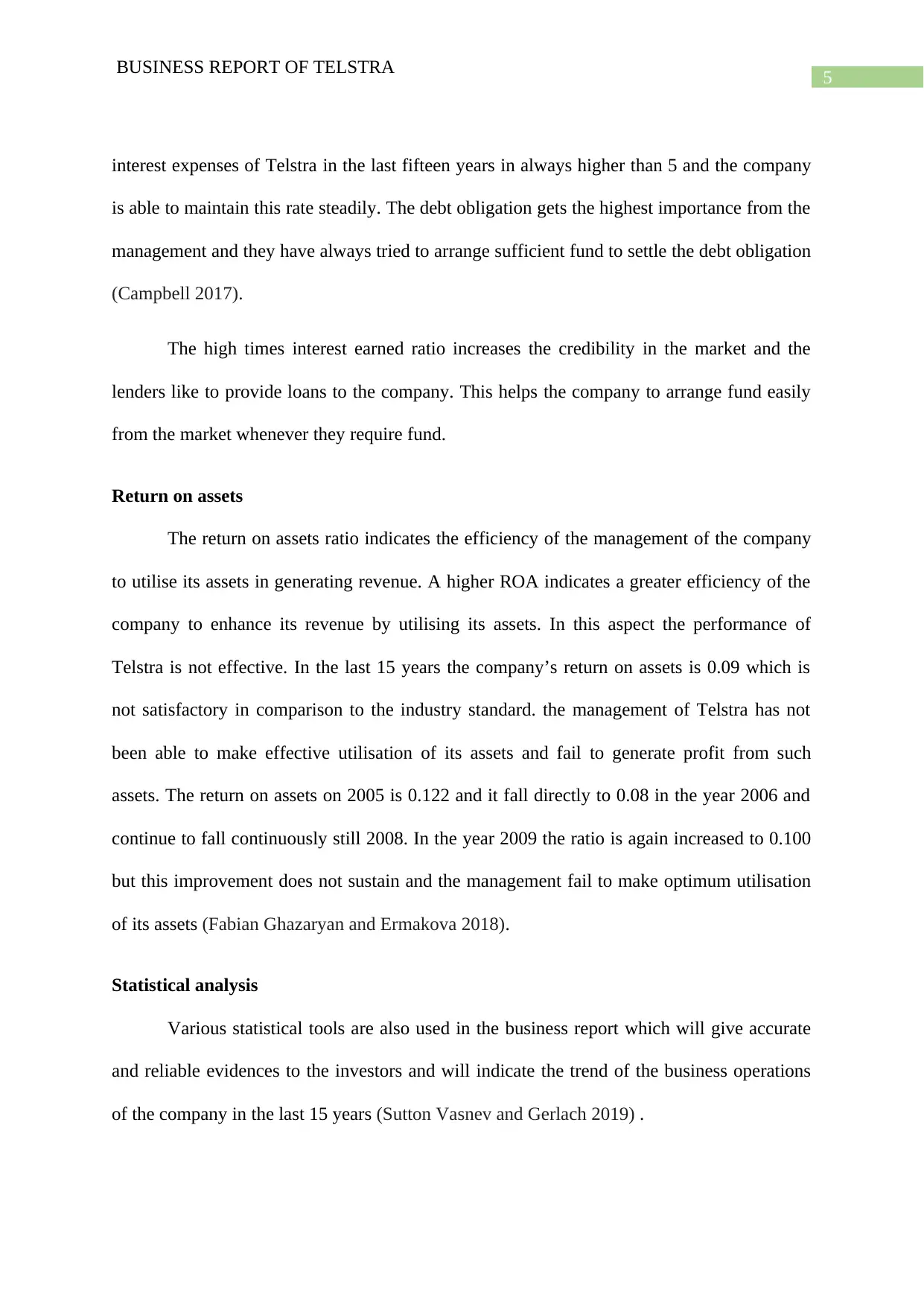
5
BUSINESS REPORT OF TELSTRA
interest expenses of Telstra in the last fifteen years in always higher than 5 and the company
is able to maintain this rate steadily. The debt obligation gets the highest importance from the
management and they have always tried to arrange sufficient fund to settle the debt obligation
(Campbell 2017).
The high times interest earned ratio increases the credibility in the market and the
lenders like to provide loans to the company. This helps the company to arrange fund easily
from the market whenever they require fund.
Return on assets
The return on assets ratio indicates the efficiency of the management of the company
to utilise its assets in generating revenue. A higher ROA indicates a greater efficiency of the
company to enhance its revenue by utilising its assets. In this aspect the performance of
Telstra is not effective. In the last 15 years the company’s return on assets is 0.09 which is
not satisfactory in comparison to the industry standard. the management of Telstra has not
been able to make effective utilisation of its assets and fail to generate profit from such
assets. The return on assets on 2005 is 0.122 and it fall directly to 0.08 in the year 2006 and
continue to fall continuously still 2008. In the year 2009 the ratio is again increased to 0.100
but this improvement does not sustain and the management fail to make optimum utilisation
of its assets (Fabian Ghazaryan and Ermakova 2018).
Statistical analysis
Various statistical tools are also used in the business report which will give accurate
and reliable evidences to the investors and will indicate the trend of the business operations
of the company in the last 15 years (Sutton Vasnev and Gerlach 2019) .
BUSINESS REPORT OF TELSTRA
interest expenses of Telstra in the last fifteen years in always higher than 5 and the company
is able to maintain this rate steadily. The debt obligation gets the highest importance from the
management and they have always tried to arrange sufficient fund to settle the debt obligation
(Campbell 2017).
The high times interest earned ratio increases the credibility in the market and the
lenders like to provide loans to the company. This helps the company to arrange fund easily
from the market whenever they require fund.
Return on assets
The return on assets ratio indicates the efficiency of the management of the company
to utilise its assets in generating revenue. A higher ROA indicates a greater efficiency of the
company to enhance its revenue by utilising its assets. In this aspect the performance of
Telstra is not effective. In the last 15 years the company’s return on assets is 0.09 which is
not satisfactory in comparison to the industry standard. the management of Telstra has not
been able to make effective utilisation of its assets and fail to generate profit from such
assets. The return on assets on 2005 is 0.122 and it fall directly to 0.08 in the year 2006 and
continue to fall continuously still 2008. In the year 2009 the ratio is again increased to 0.100
but this improvement does not sustain and the management fail to make optimum utilisation
of its assets (Fabian Ghazaryan and Ermakova 2018).
Statistical analysis
Various statistical tools are also used in the business report which will give accurate
and reliable evidences to the investors and will indicate the trend of the business operations
of the company in the last 15 years (Sutton Vasnev and Gerlach 2019) .
⊘ This is a preview!⊘
Do you want full access?
Subscribe today to unlock all pages.

Trusted by 1+ million students worldwide
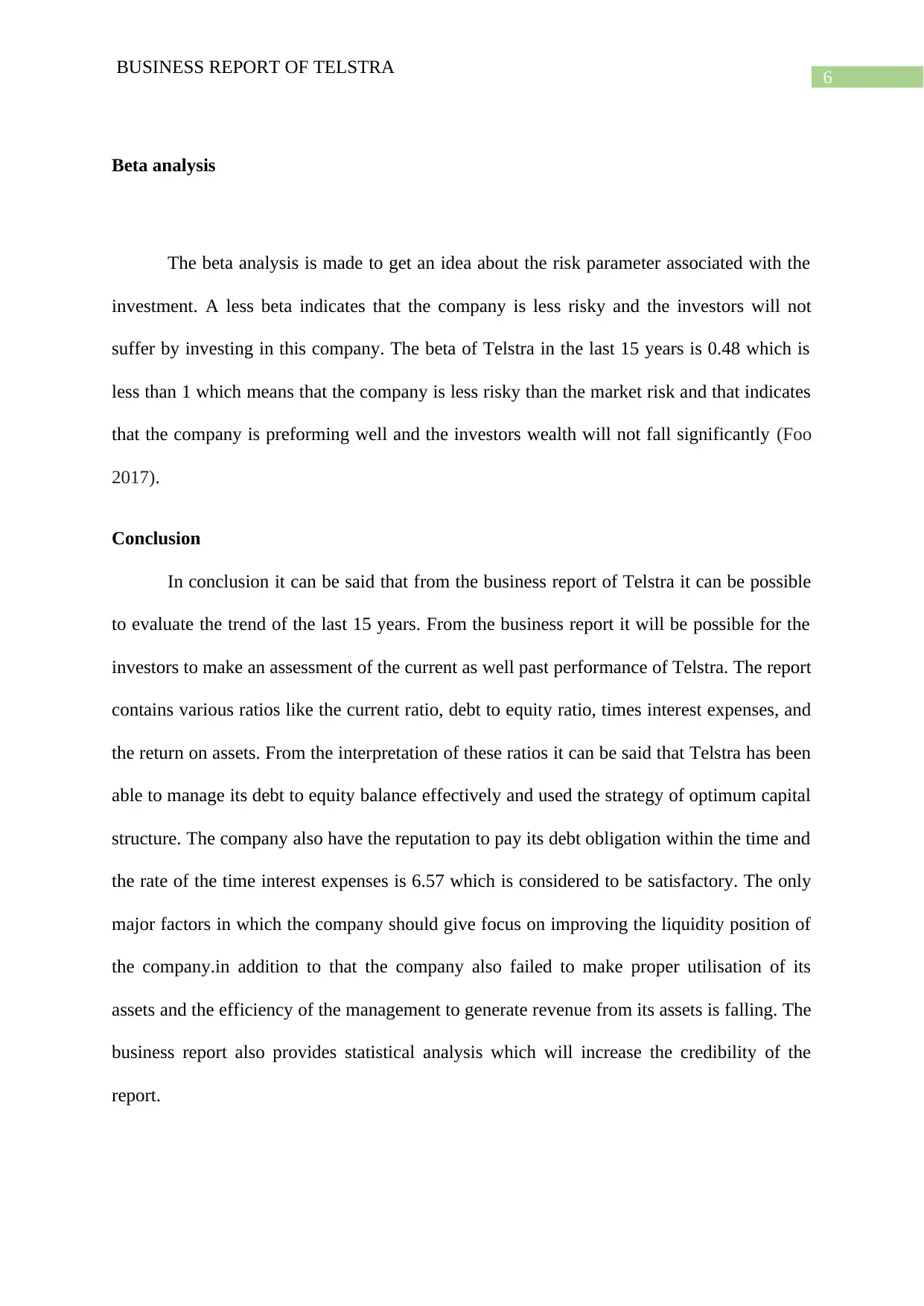
6
BUSINESS REPORT OF TELSTRA
Beta analysis
The beta analysis is made to get an idea about the risk parameter associated with the
investment. A less beta indicates that the company is less risky and the investors will not
suffer by investing in this company. The beta of Telstra in the last 15 years is 0.48 which is
less than 1 which means that the company is less risky than the market risk and that indicates
that the company is preforming well and the investors wealth will not fall significantly (Foo
2017).
Conclusion
In conclusion it can be said that from the business report of Telstra it can be possible
to evaluate the trend of the last 15 years. From the business report it will be possible for the
investors to make an assessment of the current as well past performance of Telstra. The report
contains various ratios like the current ratio, debt to equity ratio, times interest expenses, and
the return on assets. From the interpretation of these ratios it can be said that Telstra has been
able to manage its debt to equity balance effectively and used the strategy of optimum capital
structure. The company also have the reputation to pay its debt obligation within the time and
the rate of the time interest expenses is 6.57 which is considered to be satisfactory. The only
major factors in which the company should give focus on improving the liquidity position of
the company.in addition to that the company also failed to make proper utilisation of its
assets and the efficiency of the management to generate revenue from its assets is falling. The
business report also provides statistical analysis which will increase the credibility of the
report.
BUSINESS REPORT OF TELSTRA
Beta analysis
The beta analysis is made to get an idea about the risk parameter associated with the
investment. A less beta indicates that the company is less risky and the investors will not
suffer by investing in this company. The beta of Telstra in the last 15 years is 0.48 which is
less than 1 which means that the company is less risky than the market risk and that indicates
that the company is preforming well and the investors wealth will not fall significantly (Foo
2017).
Conclusion
In conclusion it can be said that from the business report of Telstra it can be possible
to evaluate the trend of the last 15 years. From the business report it will be possible for the
investors to make an assessment of the current as well past performance of Telstra. The report
contains various ratios like the current ratio, debt to equity ratio, times interest expenses, and
the return on assets. From the interpretation of these ratios it can be said that Telstra has been
able to manage its debt to equity balance effectively and used the strategy of optimum capital
structure. The company also have the reputation to pay its debt obligation within the time and
the rate of the time interest expenses is 6.57 which is considered to be satisfactory. The only
major factors in which the company should give focus on improving the liquidity position of
the company.in addition to that the company also failed to make proper utilisation of its
assets and the efficiency of the management to generate revenue from its assets is falling. The
business report also provides statistical analysis which will increase the credibility of the
report.
Paraphrase This Document
Need a fresh take? Get an instant paraphrase of this document with our AI Paraphraser
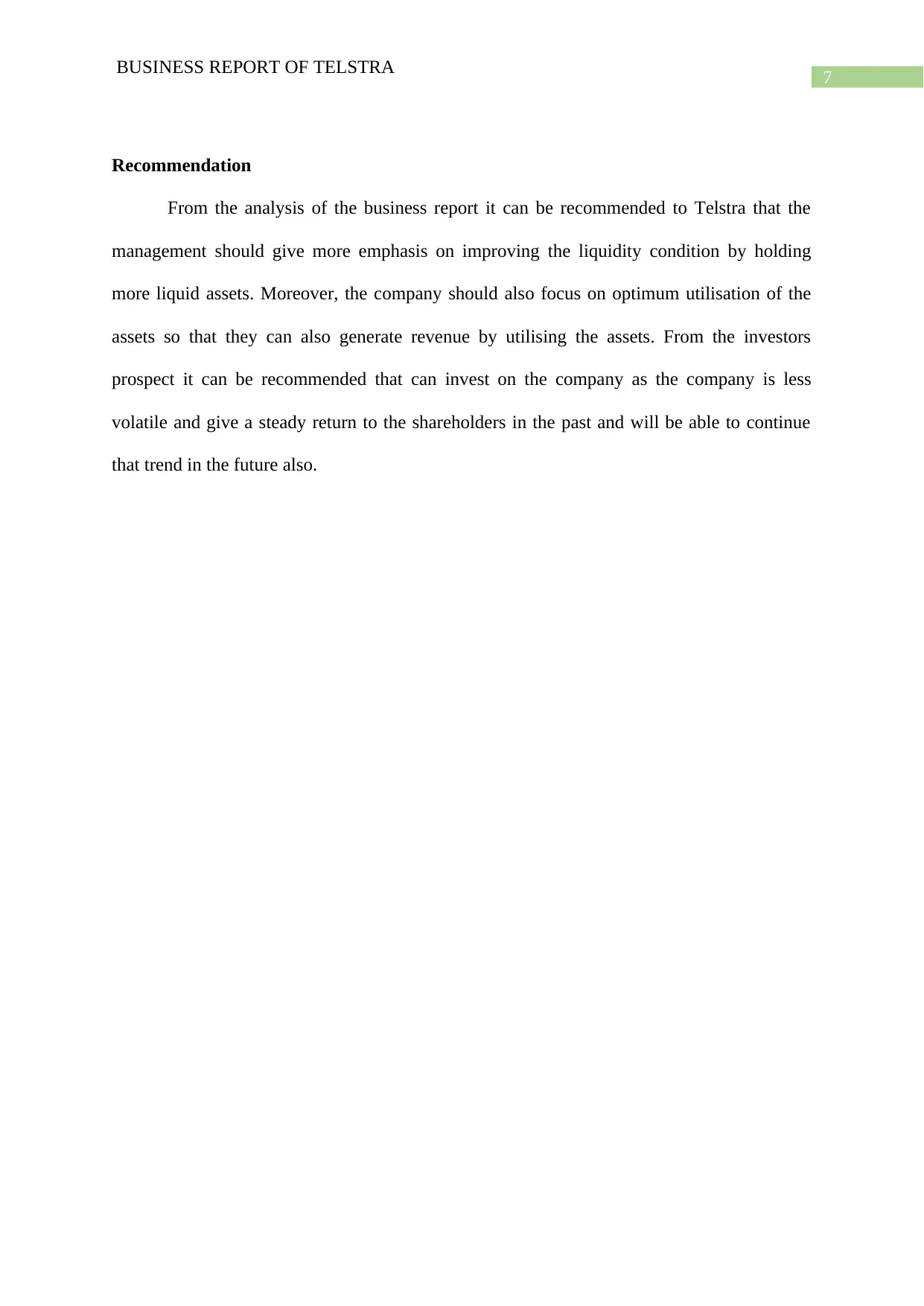
7
BUSINESS REPORT OF TELSTRA
Recommendation
From the analysis of the business report it can be recommended to Telstra that the
management should give more emphasis on improving the liquidity condition by holding
more liquid assets. Moreover, the company should also focus on optimum utilisation of the
assets so that they can also generate revenue by utilising the assets. From the investors
prospect it can be recommended that can invest on the company as the company is less
volatile and give a steady return to the shareholders in the past and will be able to continue
that trend in the future also.
BUSINESS REPORT OF TELSTRA
Recommendation
From the analysis of the business report it can be recommended to Telstra that the
management should give more emphasis on improving the liquidity condition by holding
more liquid assets. Moreover, the company should also focus on optimum utilisation of the
assets so that they can also generate revenue by utilising the assets. From the investors
prospect it can be recommended that can invest on the company as the company is less
volatile and give a steady return to the shareholders in the past and will be able to continue
that trend in the future also.
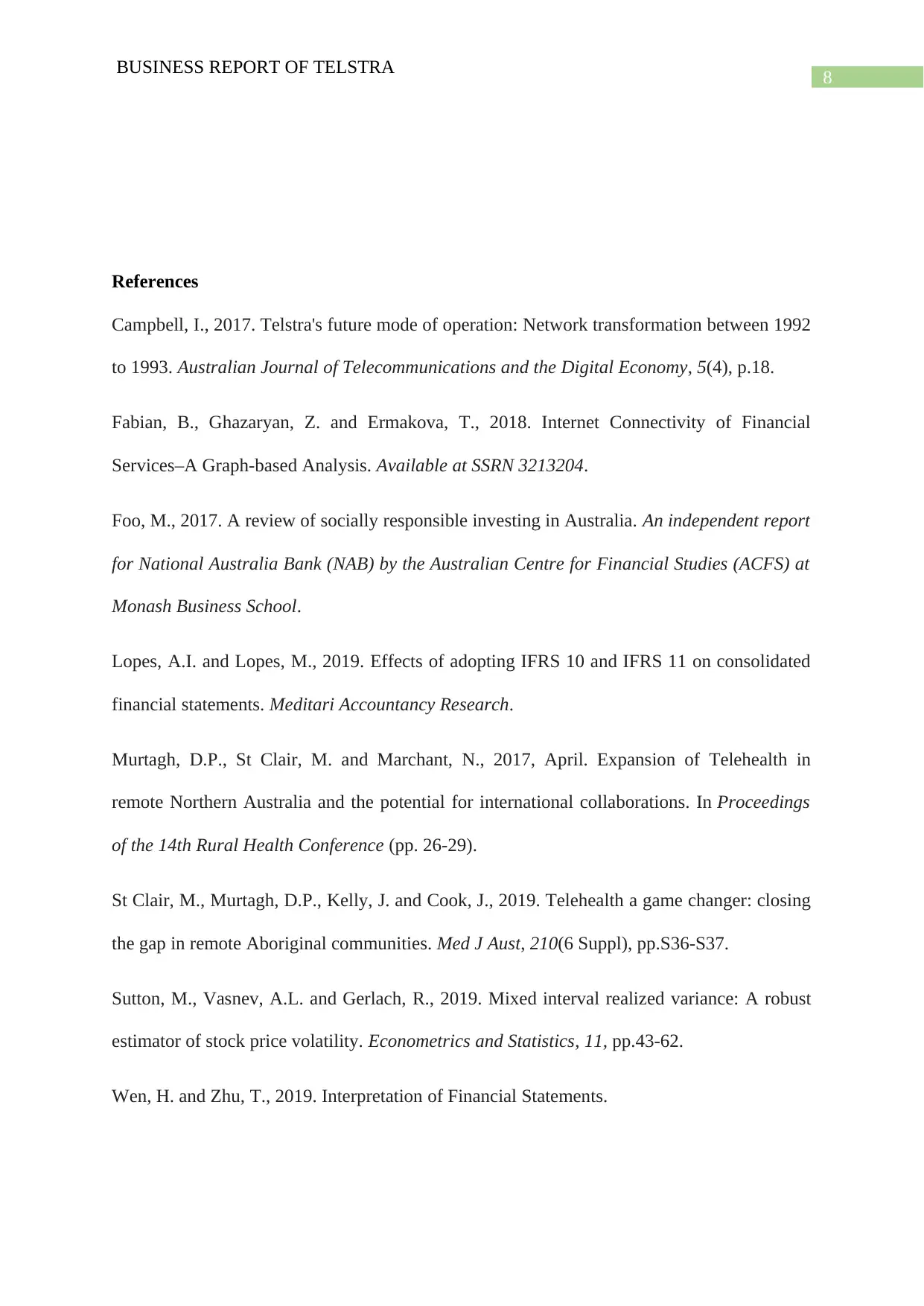
8
BUSINESS REPORT OF TELSTRA
References
Campbell, I., 2017. Telstra's future mode of operation: Network transformation between 1992
to 1993. Australian Journal of Telecommunications and the Digital Economy, 5(4), p.18.
Fabian, B., Ghazaryan, Z. and Ermakova, T., 2018. Internet Connectivity of Financial
Services–A Graph-based Analysis. Available at SSRN 3213204.
Foo, M., 2017. A review of socially responsible investing in Australia. An independent report
for National Australia Bank (NAB) by the Australian Centre for Financial Studies (ACFS) at
Monash Business School.
Lopes, A.I. and Lopes, M., 2019. Effects of adopting IFRS 10 and IFRS 11 on consolidated
financial statements. Meditari Accountancy Research.
Murtagh, D.P., St Clair, M. and Marchant, N., 2017, April. Expansion of Telehealth in
remote Northern Australia and the potential for international collaborations. In Proceedings
of the 14th Rural Health Conference (pp. 26-29).
St Clair, M., Murtagh, D.P., Kelly, J. and Cook, J., 2019. Telehealth a game changer: closing
the gap in remote Aboriginal communities. Med J Aust, 210(6 Suppl), pp.S36-S37.
Sutton, M., Vasnev, A.L. and Gerlach, R., 2019. Mixed interval realized variance: A robust
estimator of stock price volatility. Econometrics and Statistics, 11, pp.43-62.
Wen, H. and Zhu, T., 2019. Interpretation of Financial Statements.
BUSINESS REPORT OF TELSTRA
References
Campbell, I., 2017. Telstra's future mode of operation: Network transformation between 1992
to 1993. Australian Journal of Telecommunications and the Digital Economy, 5(4), p.18.
Fabian, B., Ghazaryan, Z. and Ermakova, T., 2018. Internet Connectivity of Financial
Services–A Graph-based Analysis. Available at SSRN 3213204.
Foo, M., 2017. A review of socially responsible investing in Australia. An independent report
for National Australia Bank (NAB) by the Australian Centre for Financial Studies (ACFS) at
Monash Business School.
Lopes, A.I. and Lopes, M., 2019. Effects of adopting IFRS 10 and IFRS 11 on consolidated
financial statements. Meditari Accountancy Research.
Murtagh, D.P., St Clair, M. and Marchant, N., 2017, April. Expansion of Telehealth in
remote Northern Australia and the potential for international collaborations. In Proceedings
of the 14th Rural Health Conference (pp. 26-29).
St Clair, M., Murtagh, D.P., Kelly, J. and Cook, J., 2019. Telehealth a game changer: closing
the gap in remote Aboriginal communities. Med J Aust, 210(6 Suppl), pp.S36-S37.
Sutton, M., Vasnev, A.L. and Gerlach, R., 2019. Mixed interval realized variance: A robust
estimator of stock price volatility. Econometrics and Statistics, 11, pp.43-62.
Wen, H. and Zhu, T., 2019. Interpretation of Financial Statements.
⊘ This is a preview!⊘
Do you want full access?
Subscribe today to unlock all pages.

Trusted by 1+ million students worldwide

9
BUSINESS REPORT OF TELSTRA
Yatigammana, R., Peiris, S., Gerlach, R. and Allen, D.E., 2018. Modelling and forecasting
stock price movements with serially dependent determinants. Risks, 6(2), p.52.
Zheng, X., 2019. Financial Time Series Analysis by Using MATLAB. Asian Business
Research, 4(3), p.48.
BUSINESS REPORT OF TELSTRA
Yatigammana, R., Peiris, S., Gerlach, R. and Allen, D.E., 2018. Modelling and forecasting
stock price movements with serially dependent determinants. Risks, 6(2), p.52.
Zheng, X., 2019. Financial Time Series Analysis by Using MATLAB. Asian Business
Research, 4(3), p.48.
Paraphrase This Document
Need a fresh take? Get an instant paraphrase of this document with our AI Paraphraser

10
BUSINESS REPORT OF TELSTRA
BUSINESS REPORT OF TELSTRA
1 out of 11
Related Documents
Your All-in-One AI-Powered Toolkit for Academic Success.
+13062052269
info@desklib.com
Available 24*7 on WhatsApp / Email
![[object Object]](/_next/static/media/star-bottom.7253800d.svg)
Unlock your academic potential
Copyright © 2020–2025 A2Z Services. All Rights Reserved. Developed and managed by ZUCOL.





